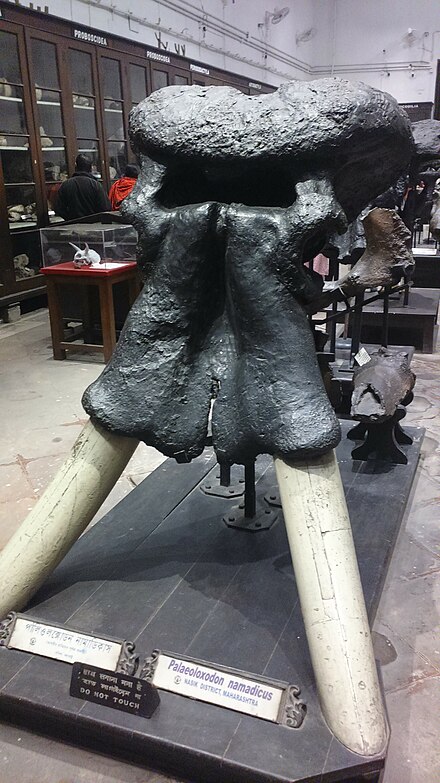Palaeoloxodon
Palaeoloxodon is an extinct genus that contains the various species of straight-tusked elephants. The genus originated in Africa during the Pliocene era, and expanded into Eurasia during the Pleistocene era. One species, Palaeoloxodon namadicus, was possibly the largest known land mammal.[2][3] The genus has a long and complex taxonomic history, and at various times, it has been considered to belong to Loxodonta or Elephas, but today is considered distinct.
In 1924, Hikoshichiro Matsumoto circumscribed Palaeoloxodon as a subgenus of Loxodonta. It included the "E. antiquus—namadicus group", and he designated "E. namadicus naumanni Mak." as its type species.[1]
Palaeoloxodon was later thought to be a subgenus of Elephas, but this was abandoned by 2007.[4] In 2016, a DNA sequence analysis of P. antiquus suggested that its closest extant relative may be the African forest elephant, L. cyclotis. The paper argues that P. antiquus is closer to L. cyclotis than L. cyclotis is to the African bush elephant, L. africana, thus invalidating the genus Palaeoloxodon as currently recognized.[5] A second study suggested P. antiquus had a complex hybridization history, with over 60% of its DNA coming from a lineage closest to but outside the two extant Loxodonta species, around 6% from Mammuthus and 30% from a lineage closer to L. cyclotis than L. africana. The hybridisation probably took place in Africa, where Paleoloxodon was dominant for most of the Pliocene and Early Pleistocene[6]
Species of Palaeoloxodon are noted for their distinctive parieto-occipital crests present at the top of the cranium, which was used to anchor the splenius as well as possibly the rhomboid muscles to support the skull, which is proportionally large in comparison to other elephants. The tusks have relatively little curvature, and are proportionally large.[8]
Palaeoloxodon first appears in the fossil record in Africa during the early Pliocene, around 4 Mya as the species Palaeoloxodon recki. P. recki was the dominant elephant in Africa for the Pliocene and most of the Pleistocene. A population of P. recki migrated out of Africa between 0.8 and 0.6 Mya, diversifying into the radiation of Eurasian Paleoloxodon species, including P. antiquus, P. namadicus, and P. naumanni, the precise relationships of the Eurasian taxa to each other are obscure in the absence of molecular evidence. P. recki became extinct in Africa around 0.5 Mya, being replaced by the modern genus Loxodonta. The arrival of P. antiquus in Europe co-incides with the extinction of Mammuthus meridionalis and its replacement by Mammuthus trogontherii, suggesting that it might have shared a similar dietary niche and outcompeted the former.[9] P. antiquus was able to disperse onto many islands in the Mediterranean, undergoing insular dwarfism and speciating into numerous distinct varieties of dwarf elephants. Palaeoloxodon fossils are abundant in China and are assigned to three species, P. namadicus, P. naumanni and P. huaihoensis.[10]
The last mainland European Palaeoloxodon faced extinction 30,000 years ago. The Japanese species possibly survived for a little longer afterwards. Among the last straight-tusked elephants were the Mediterranean dwarf species, which died out 3,000 years ago - possibly at the hands of human hunters and introduced predators.

